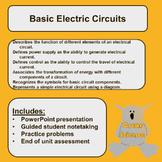33 results
High school chemistry resources in English (UK)
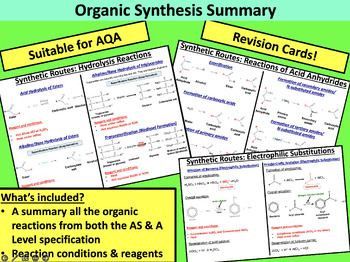
Synthetic Routes Revision (AQA)
A 16 page pdf summary of all the organic synthesis reactions from the AS and A level AQA Chemistry specification. Students will be able to use this resource directly as part of their revision on organic synthesis/synthetic routes or can make flashcards from them. Reagents and reaction conditions are also included where applicableReaction summaries include:nucelophilic substitution reactions* elimination reactions* free radical substitution reactions* electrophilic addition reactions* oxidation r
Subjects:
Grades:
11th - 12th

THE Ultimate Science Quiz Show Game- How Science Works & The Scientific Method
A MASSIVE and immersive quiz with 6 classic game show rounds with 60+ questions on How Science Works, The Scientific Method and Mathematical Skill! Set it as homework before the exams, as an independent task or play with your learners! Great for an end of year quiz! This project has been an incredibly labour of love which has taken many, many hours to complete. I know you and your learners will enjoy the challenges! Rounds include:• Pointless. The aim of the game is to score the lowest number of
Subjects:
Grades:
8th - 11th
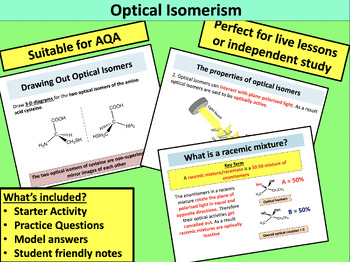
Optical Isomerism
A complete lesson including starter activity, AfL work tasks and main work tasks (all with answers included) on Optical Isomerism. Suitable for AQA A level Chemistry.By the end of this lesson KS5 students should be able to:To know which types of molecules show optical isomerismTo be able to represent enantiomers as 3D molecules showing the chiral centresTo understand why racemic mixtures are optically inactiveDeclaimer: Please refrain from purchasing this popular resource for an interview lesson
Subjects:
Grades:
10th - 12th
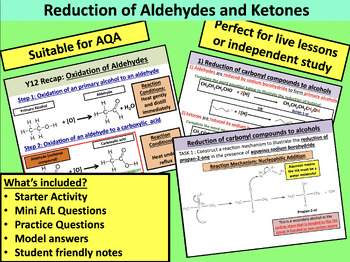
Reduction of Aldehydes and Ketones
A complete lesson including starter activity, AfL work tasks and main work tasks (all with answers included) on the Reduction of Aldehydes and Ketones. Suitable for AQA A level ChemistryBy the end of this lesson KS5 students should be able to:To review the oxidation of alcohols using Cr2O72-/H+ to form aldehydes, ketones and carboxylic acidsTo understand nucleophilic addition reactions of aldehydes and ketones with NaBH4 to form alcoholsTo construct the mechanism for nucleophilic addition reacti
Subjects:
Grades:
10th - 12th

Synthesis of Hydroxynitriles
A complete lesson including starter activity, AfL work tasks and main work tasks (all with answers included) on Synthesis of Hydroxynitriles. Suitable for AQA A level Chemistry.By the end of this lesson KS5 students should be able to:To know how to name hydroxynitrilesTo understand the steps of the nucleophilic addition reaction mechanism to form hydroxynitrilesTo be able to explain how a racemic mixture of hydroxynitriles can be producedDeclaimer: Please refrain from purchasing this popular res
Subjects:
Grades:
10th - 12th
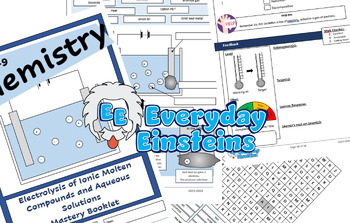
THE Ultimate Taskbook: GCSE Chemistry Electrolysis
This ULTIMATE Taskbook of Electrolysis covers the key concepts of setting up an electrolytic cell, the movement of ions in molten ionic compounds and aqueous ionic solutions and explores the industrial use of cryolite and bauxite in the extraction of molten aluminium.The Taskbook contains a range of activities from word searches, crosswords and word fit puzzles to true or false, match ups and word fill tasks.Aimed at Year 10-11 as revision or a teaching tool alongside classroom practice. It hits
Subjects:
Grades:
9th - 11th
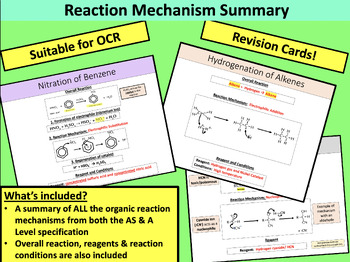
A level Chemistry: Reaction Mechanisms (OCR)
18 flashcards on Reaction Mechanisms from both Year 12 and 13 content. Suitable for the OCR A level Chemistry SpecificationReaction mechanisms included are:Free Radical SubstitutionNucleophilic SubstitutionElectrophilic AdditionElectrophilic SubstitutionNucelophilic AdditionPRINTING: These can be printed as A6 flashcards (1/4 size of A4) by printing four pages per sheet
Subjects:
Grades:
10th - 12th
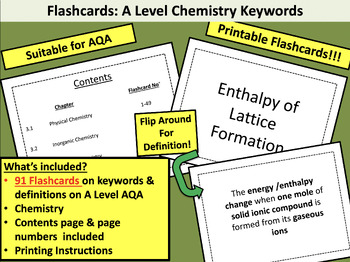
AQA A Level Chemistry Flashcard Keywords
91 flashcards on AQA A level Chemistry keywords and definitions - Year 12 and 13 contentSpecific printing instructions have been included and should be followed so that flashcards can be successfully printed.Important Note: These flashcards are only suitable to be printed as A6 flashcards (1/4 size of A4)Included are keywords from the following AQA A Level chemistry modules:3.1 Physical Chemistry3.2 Inorganic Chemistry3.3 Organic Chemistry
Subjects:
Grades:
10th - 12th
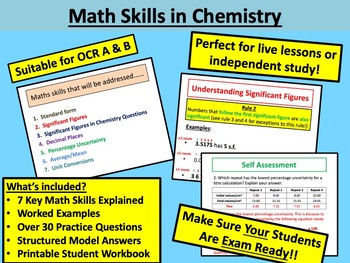
Math Skills in Chemistry
Maths skills is a key component in all A level chemistry exam papers therefore this resource is fundamental in supporting your students to be A level Chemistry Exam ready (Note: This resource is suitable for students studying the AS or A Level Chemistry OCR A or B Exam Board). This resource can be completed as a lesson (~2-3 hrs required) or more conveniently it can be set as homework for students to complete independently. This resource can also be presented to students in small segments across
Subjects:
Grades:
11th - 12th
Types:
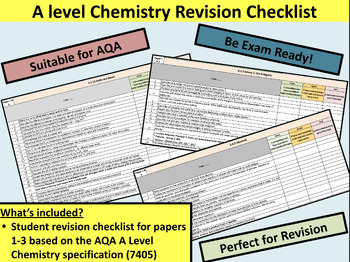
AQA A Level Chemistry Specification Checklist
Student friendly personalised learning checklist for AQA A level Chemistry (7405)This resource includes key specification statements for papers 1-3This resource has ben split into three separate Excel documents for:3.1 physical chemistry3.2 inorganic chemistry3.3 organic chemistryThe exam paper number linked to each topic can be found in the left hand corner of each checklist to aid student exam revision.
Subjects:
Grades:
11th - 12th
Types:
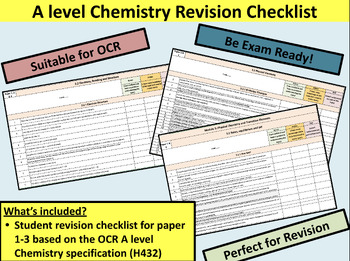
OCR A Level Chemistry Specification Checklist
Student friendly personalised learning checklist for OCR A level Chemistry (H432)This resource includes key specification statements for papers 1-3This resource is one Excel document with tabs for:Module 2: Foundations in ChemistryModule 3: Periodic Table and EnergyModule 4: Core Organic ChemistryModule 5: Physical Chemistry and Transition ElementsModule 6: Organic Chemistry and AnalysisThe exam paper number linked to each topic can be found in the left hand corner of each checklist to aid stude
Subjects:
Grades:
11th - 12th
Types:
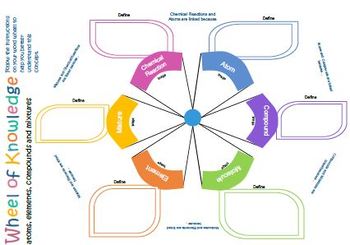
Atoms, Elements, Mixtures, Compounds - Wheel of Knowledge
The resource focuses on understanding the differences between atoms, elements, compounds, mixtures, molecules. (I have included an example completed by one of my students for ease of reference).The resource is designed to make them think hard, but it its your job to ensure that they are aware that it is okay to get it wrong.The task includes a definition (either in students’ own words or from suitable text), explain using a diagram, apply by linking terms.The activity is best done after a teache
Subjects:
Grades:
5th - 12th, Higher Education, Adult Education
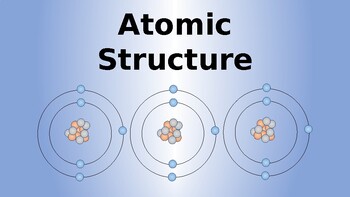
Nuclear Radiation Lesson Pack (11 lessons)
A full set of 11 presentations on the subject of nuclear radiation, tried and tested in the classroom.The following is a list of the lessons included:1. Atomic Structure2. Radioactive Decay3. Background Radiation4. Nuclear Equations5. Radioactive Half-life6. Hazards and Uses of radiation7. Irradiation8. Uses of radiation in Medicine9. Nuclear Fission10. Nuclear Fusion11. Developing the Ideas for the Structure of the Atom
Subjects:
Grades:
6th - 10th
Also included in: Physics Lesson Bundle
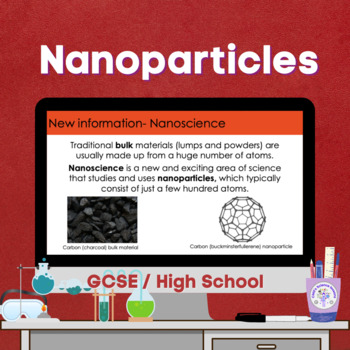
Nanoparticles (GCSE)
During this lesson (nanoparticles) GCSE / High School students work through a variety of activities to develop their understanding of what nanoparticles are and compare their sizes to atoms and molecules. This is the 11th lesson from the GCSE Chemistry C3: Structure and bonding topic. Also available as a digital worksheet, which is ideal for distance learning, independent study or catch-up of missed work through absence. Presentation contains (25 slides)- Bell work activity Lesson objective and
Subjects:
Grades:
9th - 11th
Also included in: C3 Structure and bonding (GCSE)
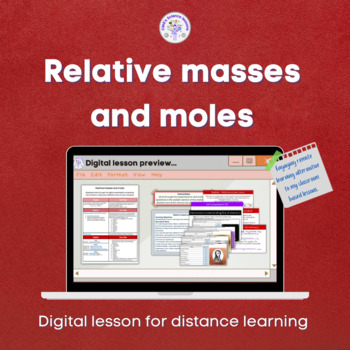
Relative masses and moles Distance learning (GCSE)
This digital worksheet introduces AQA GCSE (High School) students to relative masses and moles. During the lesson students work through the digital worksheet completing a variety of tasks to develop their understanding of how to calculate the relative mass of a compound. Ideal for independent & distance learning / homeschool / covering missed content after absence / non-specialist cover lesson Aimed at a mixed ability class (GCSE / High School) This resource includes:Teacher guidance and ans
Subjects:
Grades:
9th - 12th
Also included in: Relative masses and moles Lesson bundle (GCSE)

Evaporation & Condensation Survival Activity and text for Struggling Scientists
Objectives: To understand how evaporation is linked to thermal energy transferTo understand how to change the rate of evaporation/condensationI have found this works best in small groups where students can discuss ideas. The activity should take about 40 minutes and then another 20 minutes for peer assessment.Activity overview:Give higher achievers a text book and lower achievers the accompanying text. I usually allow students to answer whichever questions they wish but generally find that they
Subjects:
Grades:
6th - 12th
Types:
NGSS:
HS-PS3-4

Organic Synthesis , Spectroscopy and Aromaticaly (CHEMISTRY) Note chapter 02
Includes (With mechanisms and examples) perfectThe diels-alder Reaction and RulesEndo and Exo product are formed in the Diels-alder ReactionFormation of Alkenes the writting reactionPhosphorus YlidesFormation of Alkenes- Sulfur YlidesReaction With Cabonuyl Amines and akenesOrganometallic ReagentsPre[aration Of OrganometallicsMetal -hydrogen Exchange (metalation)OrganoLithium CompoundsReactivity of Organolithium CompoundsOrganocuprates(Gilman Reagent)Protecting GroupsBaeyer-Villiger oxidationcal
Subjects:
Grades:
11th - 12th, Higher Education, Adult Education, Staff

Atoms into ions (GCSE)
During this lesson (atoms into ions) GCSE / High School students work through a variety of activities to develop their understanding of how atoms can form positive or negative ions to make compounds. This is the 2nd lesson from the GCSE Chemistry C3: Structure and bonding topic. Also available as a digital worksheet, which is ideal for distance learning, independent study or catch-up of missed work through absence. Presentation contains (25 slides)- Bell work activity Lesson objective and succe
Subjects:
Grades:
9th - 11th
Also included in: C3 Structure and bonding (GCSE)

Relative masses and moles (GCSE)
This lesson presentation introduces AQA GCSE (High School) students to relative masses and moles. During the lesson students complete a variety of tasks to develop an understanding of how to calculate the relative mass of a compound. Also available as a digital worksheet, which is ideal for distance learning, independent study or catch-up of missed work through absence. Presentation contains (28 slides)- Bell work activity Lesson objective and success criteria Information slides Challenge act
Subjects:
Grades:
9th - 12th
Also included in: Relative masses and moles Lesson bundle (GCSE)
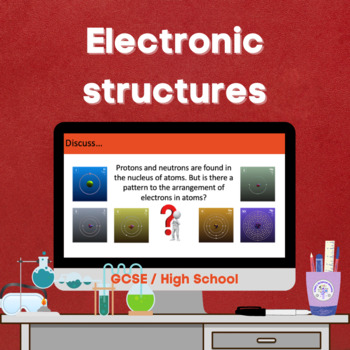
Electronic structures (GCSE)
During this lesson (electronic structures) GCSE / High School students work through a variety of activities to develop their understanding of how electrons are arranged in the first 20 elements. This is the 8th lesson from the GCSE Chemistry C1: Atomic structure topic. Also available as a digital worksheet, which is ideal for distance learning, independent study or catch-up of missed work through absence. Presentation contains (30 slides)- Bell work activity Lesson objective and success criteri
Subjects:
Grades:
9th - 11th
Also included in: C1 Atomic structure bundle (GCSE)

Structure of the atom (GCSE)
During this lesson (structure of the atom) GCSE / High School students work through a variety of activities to develop their understanding of the structure of an atom and the relative charge and masses of protons, neutrons, and electrons. This is the 6th lesson from the GCSE Chemistry C1: Atomic structure topic. Also available as a digital worksheet, which is ideal for distance learning, independent study or catch-up of missed work through absence. Presentation contains (25 slides)- Bell work a
Subjects:
Grades:
9th - 11th
Also included in: C1 Atomic structure bundle (GCSE)

Explaining trends in the Periodic table (GCSE)
During this lesson (explaining trends) GCSE / High School students work through a variety of activities to develop their understanding of the trends in reactivity in Group 1 and Group 7. This is the 5th lesson from the GCSE Chemistry C2: The Periodic table topic. Also available as a digital worksheet, which is ideal for distance learning, independent study or catch-up of missed work through absence. Presentation contains (27 slides)- Bell work activity Lesson objective and success criteria Info
Subjects:
Grades:
9th - 11th
Also included in: C2 The Periodic table (GCSE)
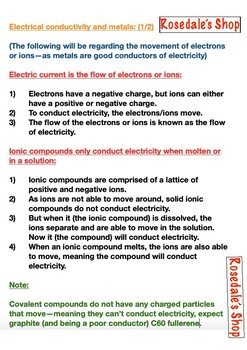
Electrical Conductivity & Metals | Secondary School Chemistry Lesson Notes
In this mini file we elaborate on "Electrical Conductivity and Metals". This resource can be used as a lesson guide for teachers, or a revision source for students to obtain a full insight to this chemistry subject.In addition, this PDF can be used to print and handout to students to aid them increase science reading comprehension and science literacy in your classroom. Ultimately, this resource is undoubtedly helpful as a revision guide to those about to embark on secondary-school exams, as th
Subjects:
Grades:
8th - 10th
Types:
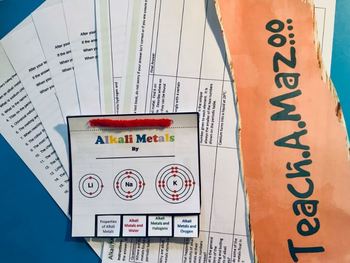
Alkali Metals / Group 1 Metals Activity Pack
Objectives:To understand the properties of the Group 1 MetalsTo understand how Group 1 Metals react with oxygen, halogens and waterTo understand how and why the elements change going down the groupIncluded:Card Sort and Answer SheetThe card sort has 15 words/phrases to be matched with question cards.Directed Assessment and Feedback TaskStudents start this activity by folding the worksheet in half and answering the questions in the space provided. They then open the worksheet out and improve/co
Subjects:
Grades:
7th - 12th, Higher Education, Adult Education
Types:
Showing 1-24 of 33 results


